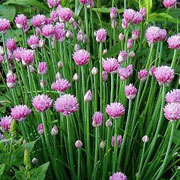


Home
Flowers &
Indoor Plants
Fruits & Nuts
Ornamentals
Vegetables
Special Topics
Resources
Glossary

|
Chives Allium schoenoprasum (all-ee-um shen-o-pras-um) 



Click on thumbnails for larger image. |
 |
What about it? Once you plant chives in your garden, chances are you'll always have them. Chives are hardy perennial plants and can be easily dug up, divided, and moved as your garden evolves over the years. Common chives grow to a foot tall and have narrow, hollow green leaves and spherical pink or purple flowers. What is it used for? The leaves of a chive plant are used in all kinds of sauces and salads to lend a delicate onion flavor. They can also be used as a garnish. When added to white vinegar, the flowers impart a lovely pink or purple color. In addition, the flowers may be used to garnish salads and soups. Chives may be used fresh or frozen but do not retain their flavor well when dried. Where does it grow? How do we grow it? You can start chives from seed or just divide an old plant. If you want to start from seed, sow it 1/4 inch deep in flats or directly in the garden in early spring. Dividing can be done at any time during the growing season by separating an existing plant into smaller ones. Once established, each clump will need a foot or so of room. Chives prefer sunny or slightly shady areas. They also grow best in rich soil and will tolerate either moist or dry conditions. What are its primary problems?Chives are not particularly vulnerable to any pests or diseases. Some people consider its ability to spread a potential problem. How do we harvest and store it? Chives can be harvested 6 weeks after planting. Cut the outer leaves down to the base. Chives do not retain their flavor when dried, so use them fresh or freeze them. You can begin harvesting about 6 weeks after planting or as soon as established plants resume growth in the spring. As you need leaves, cut the outer ones right back to the base. After being cut, the chives may be used fresh, frozen, or dried for later use.
© Copyright, Department of Horticulture, Cornell University. |